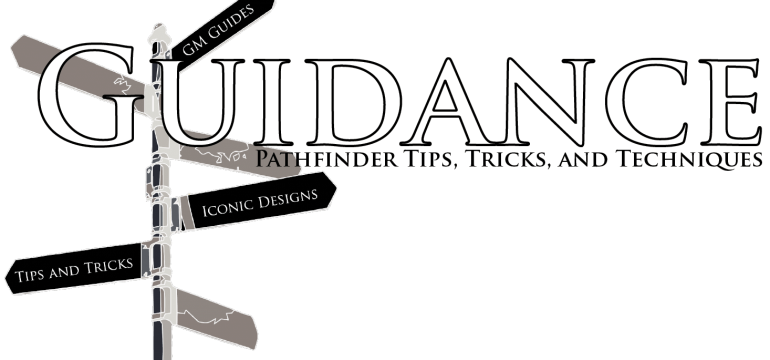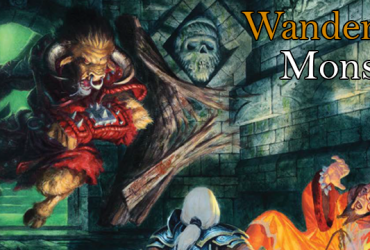Last installment, we discussed the origins of the terms “Mark,” “Smart Mark” (aka “Smark”) and “Smart” as they pertained to the WWE. We also discussed how those terms related back to the Pathfinder Roleplaying Game—specially how different people view RPG content. Today, we’re going to take this information to the next logical step; game design.
Before we begin, I’d like to state the obvious—not every Smark likes the same kind of content, and not every Mark likes the same kind of content. Few things in life are black and white—life is a spectrum, and when we free ourselves from binary thinking, we begin to truly be able to understand our fellow man. (Or elf. Or dwarf. Or gnome. Or halfling. Or kitsune. Or ratfolk….)
That said, there are strategies we CAN use to make things attractive to both sides of the coin when we’re designing. That’s because a pure-Mark player is looking for something very different from a pure-Smark player, and today we’re going to go over both.
Marks, or, “Do These Pants Make Me Look Fat?”
When designing for Marks, “image” is the first thing you should think of. In this respect, the Mark player is very much a fashionesta—he wants every option he takes to directly add to the overall presentation of his character, if he can help it. Presentation, as used here, refers to the manner in which the Mark uses his character to interact with the game world. As a result, Marks prefer options that are tied to specific locations and places in campaign settings. They also like options that give mechanical justification to their character’s background. “My character is from Varisia, so she has the X feat and the Y archetype.”
This doesn’t mean that Marks shy away from options that lack setting flavor or power. On the contrary, they’re all about setting neutral options as long as they create something cool in their heads. For instance, Improved Familiar is a very powerful feat, but when a Mark looks at it, he often says, “I want this because it gives me a companion BFF that fits perfectly with my character’s presentation.” They want the angel familiar because their character is good and associated with angels, or they want the pipefox familiar because they’re going with a Japanese yokai theme. They love archetypes like the kami medium, which creates a very vivid, very specific style of character.
Now, what options do Marks hate? They often dislike options that they feel EVERYONE has. Marks crave uniqueness of character, just like every other player, but unlike Smarks, who solely want uniqueness of effect, Marks want uniqueness of source too. They also often want things that make them cool and special both on and off the battlefield—they are far more likely to appreciate a more niche option with few combat uses and appreciate options that only work out of character. Feats like Orator or Esoteric Linguistics are much more the domain of Marks than Smarks for this reason.
Smarks, or, “Do These Pants Protect Me From Conflagration?”
Smarks want one thing, and one thing only—results. For them, options are the means with which they build their character, and unlike Marks they don’t often care too much of the options precisely fit every small little aspect of their character. If Marks are Fashionestas, Smarks are Lumberjacks—they wear what they like and what they like is stuff that suits them. They don’t care if things are “stereotypical” and “cookie cutter” is a feature, not a flaw. More then anything, Smarks want their cool build concept / idea to work, and they often want it to work efficiently. To them, what their character DOES is more important than who their character IS. They want to be able to say, “My character is a fencing champion from Varisia, and she can do X, Y, and Z.”
As implied with that last statement, Smarks are not afraid to pick options that befit their characters or their backgrounds. However, those options need to be effective at whatever playstyle their character has, and they’re not afraid to build their character’s history and personality around the options they pick. For example, a Smark would see no problem with being a trans boy from Varisia who left home and studied at the University of Lepidstalt to take the Ustalavic Duelist archetype before traveling off to Qadira where the campaign is set to begin. In essence, a Smark takes what options are available and tweaks them to suit their character.
Now, what options do Smarks hate? Well, some Smarks, despite what was said above, HATE things with explicated ties to a specific campaign setting. This is an issue of customization—they want to be able to pick out the fabric of their clothes, choose the color, and tailor it to who their character is. They don’t care about how “pretty” the fabric was at the beginning as well as it does the job the Smark wants it to do. Smarks also hate options that they personally perceive as “useless,” which we’ll define as, “Something that wouldn’t make my character better.” For instance, they’d look at the Orator or Esoteric Linguistics feat and call it garbage because it isn’t a feat they could see themselves taking.
Designing for Smarks and Marks
At first, these goals seem counterintuitive. How do you make something rich in flavor for one person, yet easily tailorable to unique characters for another?
Well, if we look at the lists for each Smark and Mark, we come up with the following common themes:
— Must be evocative. (Marks)
— Must be customizable. (Smark)
— Must be cool and unique. (Mark)
— Must be pragmatic and worth taking. (Smark)
So, the best way to hit all of these things is as follows:
1) Keep the flavor to the descriptive text. Archetypes and feats both have “descriptive entries,” and the best way to make the Mark happy and the Smark sated is to keep your flavor in those places. Use that space to tell the Mark how your option fits in the campaign world or talk up the option so your Mark player is hyped up, but don’t use too much of that setting flavor in the actual mechanics of the feat so the player has more freedom to decide how their character interacts with that option. Note that Smark players will forgive moving flavor to other parts of an archetype or feat if the flavor makes mechanical sense. For instance, having a feat for kitsune that alters how Change Shape works or an archetype for drow that builds on their racial spell-like abilities will feel fitting to a Smark because those options have direct mechanical ties into their respective races. But no ties, no good according to most Smarks.
2) Make your option cinematic and tailored to a specific playstyle. Marks hate it when they feel their options aren’t special, and Smarks want to play viable options. Therefore, the best way to make a new option is to design it in a way that it exploits “mechanical niche” that has few options available to it. (Or that is restricted to a specific type of character—broading niches, confusingly, is also a niche you can explore if you are gingerly designing said new option.)
3) Make your option useful and helpful. Marks want to feel cool and awesome, and Smarks don’t want to waste their time with terrible options, so make sure that your option feels cool and is also an option that is mechanically viable.
Next Time
Whelp, that’s all I have to say on designing for Smarks and Marks this week. Next week, I am going to be shifting gears to talk about what is my favorite kind of design—race design. Races are a HUGE part of both your character creation and your setting creation, so designing cool, interesting races is vital both to get players and GMs interested in your game.
So until next time, I’m Alex Augunas and I’m always here for YOU when you need a little bit of Guidance. Take care!
Alexander “Alex” Augunas has been playing roleplaying games since 2007, which isn’t nearly as long as 90% of his colleagues. Alexander is an active freelancer for the Pathfinder Roleplaying Game and is best known as the author of the Pact Magic Unbound series by Radiance House. Alex is the owner of Everyman Gaming, LLC and is often stylized as the Everyman Gamer in honor of Guidance’s original home. Alex also cohosts the Private Sanctuary Podcast, along with fellow blogger Anthony Li, and you can follow their exploits on Facebook in the 3.5 Private Sanctuary Group, or on Alex’s Twitter, @AlJAug.






